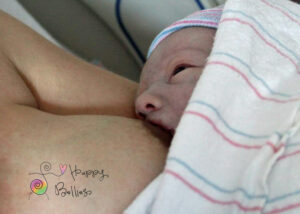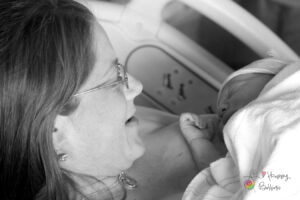Vaginal Seeding for a Cesarean Birth
Tara Carpenter, PES.
Placenta Encapsulation Specialist for new mothers in Vermont and New Hampshire.
Originally published on November 25, 2018.
This photo is a client of mine who gave birth via cesarean (c-section) “cesarean” which origins from the Latin word caedare, meaning “to cut”. Before surgery, this mom requested that her doctor insert a piece of gauze into her vaginal canal; then use this gauze seconds after she gave birth to swab inside her baby’s mouth, around her eyes, and on her skin.
This somewhat new practice is known to help colonize baby’s gut with beneficial microflora. The idea is to give her a better start in life. “Seeding” is getting more attention from doctors that perform c-sections and concerned mothers who need to have one.

The crucial “founding microbiome” begins as babies pass through the birth canal.
How it works for a c-section birthed baby…
During a c-section birth, the baby doesn’t come into contact with mom’s vaginal flora. Instead she receives more bacteria from airborne bacteria and from her mom’s (and dad) if there is skin-to-skin.. And from the doctor, nurse(s), etc. The baby’s bacterial will resemble the bacteria in this way.
This can be a concern because this primary colonization of random types of bacteria can make baby more susceptible to harmful pathogens and illness; especially down the road in years to come. Like type 1 diabetes, asthma, allergies, eczema, and other gut issues.

One drop of breastmilk contains over 1 million living cells, antibodies to protect against illness, and hormones to aid baby’s development.
How it works for a vaginal birthed baby…
During a vaginal birth, the baby comes in direct contact with mom’s vaginal flora. Unless you got a baby born in the caul (amniotic sac) but typically these membranes rupture and the mom’s water breaks. At this point baby’s gut flora is immediately colonized by mom’s own flora and these colonies continue to be planted as the baby’s moves down and out through the birth canal.
A vaginal baby is literally coated with a huge and diverse quantity of its mom’s microbes. And right after birth, that baby’s bacterial community will resemble the bacteria that live in the mom’s vagina.

The main concerns…
If mom’s vaginal health is imbalanced or if she has an infection (i.e., GBS+) then there’s a risk in spreading that infection to the baby. This is why every mom is screened for healthy microbial ecology prior to “seeding”. The doctor or midwife would check to make sure mom doesn’t have HIV, GBS+, STD, etc.
This isn’t fecal transplant and though this may sound gross the female body is designed to have a baby come out through the vagina. That baby is going to be rubbed all around the birth canal. As it comes out of the vagina baby will also gulp in some vaginal fluids through his or her mouth.

Skin-to-skin can give baby’s immune system a boost by introducing bacteria from mom’s skin to contribute to the establishment of the gut microbiome.
Maybe a little weird…
A c-section is a procedure that is often necessary for both mom and baby. Seeding is an option to mimic the vaginal birthing process. Bring the two together into something more whole for baby to experience. Seeding is simply exposing a baby partially to the natural environment that he or she would have experienced if it’d been born through it’s mom’s vagina.
The logical part…
During a vaginal birth, a baby’s face rubs against the mucous membranes of the birth canal. This can go on for quite some time as the contractions pulse and push the baby out. Then the baby’s face, and often her open mouth, is in direct contact with the mom’s vaginal flora.
This means, that before that baby is out of the birth canal, the bacteria have started to grow and multiply in #’s in his or her mouth and down the tract. In this way, the entire birth process is much more than a baby coming out – it’s a major colonizing process.

Birth is just one factor involved in the development of a baby’s microbiome; breastfeeding is a really important piece of the puzzle, and skin-to-skin contact is helpful too.
References
https://www.theguardian.com/…/vaginal-seeding-c-section-babi…
https://commonhealth.wbur.org/2014/06/birth-canal-bacteria-c-section
Preparing Birth Canal for Probiotic Gulp, Healthy Home Economist
https://commonhealth.wbur.org/2014/06/birth-canal-bacteria-c-section
Levy, K. (2013). My Baby, My Microbiome.
Protecting Your Baby’s Microbiome from the Start
Cultivate Health From Within, by Dr. Khem Shahani, Ph.D.
May all bellies be happy
Disclaimer: Content is for general information only; primarily educational in nature; and not to be treated as a substitute for medical advice of your health care professional that you, the reader, may require for any cause whatsoever, now or in the future. Always consult your doctor regarding any health problem(s) you have and keep him/her informed to opinions, ideas, and dietary advice offered here that you find useful. Full disclaimer here.


